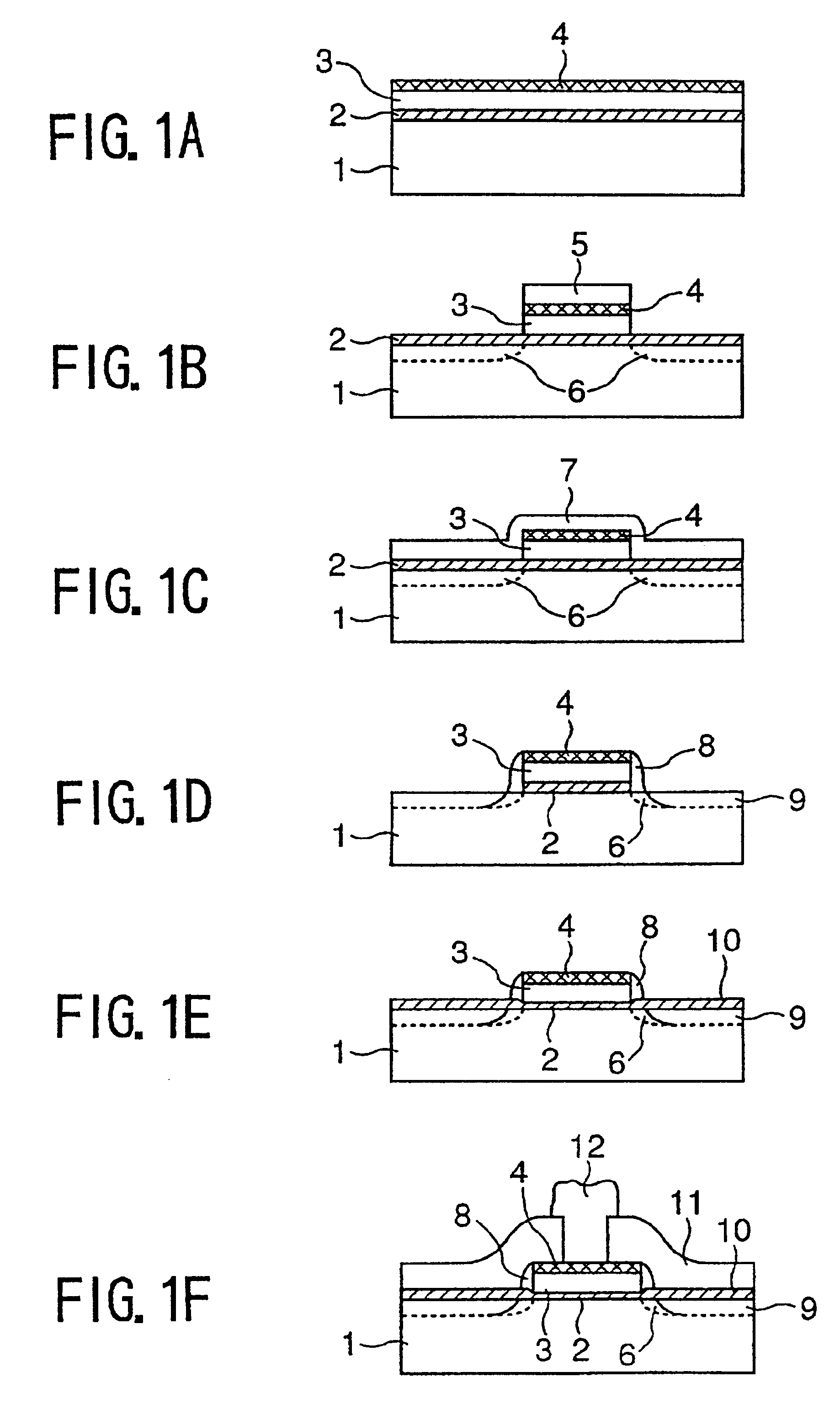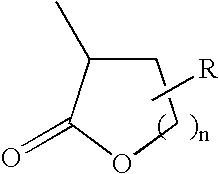Polymer compound for a chemical amplification resist and a fabrication process of a semiconductor device using such a chemical amplification resist
a technology of chemical amplification resist and polymer compound, which is applied in the direction of photosensitive materials, instruments, photomechanical devices, etc., can solve the problems of high cost of mevalonic lactone source material, strong optical absorption of resist, and inability to resist strong optical absorption
- Summary
- Abstract
- Description
- Claims
- Application Information
AI Technical Summary
Benefits of technology
Problems solved by technology
Method used
Image
Examples
first embodiment
Synthesis of γ-Butylolactone-2-yl Methacrylate
[0077]A three-neck flask of 200 ml size is dried thoroughly and filled with N2, after connecting thereto a dropping funnel, a calcium chloride tube and a N2 supply tube at respective necks. Next, 50 ml of dry methylene chloride, 5.0 g (48.9 mmol) of 2-hydroxy-γ(gamma)-butylolactone, and 5.45 g (53.9 mmol) of dry triethylamine are introduced into the three-neck flask and stirred in an N2 atmosphere at 0° C. by using a teflon-coated stirrer bar.
[0078]Next, 5.11 g (48.9 mmol) of methacryloyl chloride previously held in the dropping funnel is introduced by a dropping process conducted for 1 hour, and the liquid thus obtained is stirred at a room temperature for 2 hours. The resultant solution is then taken into a separating funnel of a 300 ml size, and the solution thus taken is washed with 100 ml of water, followed by washing with a saturated sodium chloride water. Thereby, the water layer is extracted three times with methylene chloride, a...
second embodiment
Synthesis of a Copolymer of γ-Butylolactone-2-yl Methacrylate and 2-Methyl-2-Adamantyl Methacrylate
[0081]A flask of 100 ml size is used to hold 3 g (17.6 mmol) of γ(gamma)-butylolactone-2-yl methacrylate, 3.51 g (14.4 mmol) of 2-methyl-2-adamantyl methacrylate, 788 mg (4.8mmol) of AIBM (15 mol %) and 10.7 ml of dioxane, together with a magnetic stirrer bar, and the mixture in the flask is stirred by using the magnetic stirrer bar in a dry N2 environment at a temperature of 70° C. for 8 hours. A resultant viscous fluid is added dropwise in 800 ml of methanol, to form a precipitate.
[0082]Next, the precipitate is filtered by using a glass filter and the resin thus filtered is dried in a vacuum oven at 45° C. for 6 hours. The resin thus obtained is then dissolved into THF. After repeating the precipitation purification twice by using methanol, the resin is dried in the vacuum oven at 45° C. for 18 hours. As a result, a whitish resin powder is obtained with a yield of 5.35 g (82.2%).
[008...
third embodiment
[0087]The copolymer synthesized in the second embodiment is dissolved into PGMEA (propyleneglycol methylether acetate) to form a 15 wt % solution. The solution is further added with 8 wt % γ(gamma)-butylolactone as the auxiliary solvent. The solution thus obtained is further added with 2 wt % of triphenylsulfonium trifluorosulfonate for complete dissolution.
[0088]The resist solution thus obtained is then filtered by a teflon membrane filter of 0.2 μm size and spun onto a Si substrate processed by HMDS, to form a resist film. The resist film thus formed is subjected to a prebaking process at 120° C. for 60 seconds, and a resist film having a thickness of 0.7 μm.
[0089]The resist film thus obtained is then subjected to an exposure process, in which the exposure process is conducted by a KrF excimer laser stepper having a numerical aperture of 0.45.
[0090]After the exposure, the resist film is subjected to a PEB process at a temperature of 110° C. for 60 seconds, ...
PUM
| Property | Measurement | Unit |
|---|---|---|
| thickness | aaaaa | aaaaa |
| width | aaaaa | aaaaa |
| wavelength | aaaaa | aaaaa |
Abstract
Description
Claims
Application Information
 Login to View More
Login to View More - R&D
- Intellectual Property
- Life Sciences
- Materials
- Tech Scout
- Unparalleled Data Quality
- Higher Quality Content
- 60% Fewer Hallucinations
Browse by: Latest US Patents, China's latest patents, Technical Efficacy Thesaurus, Application Domain, Technology Topic, Popular Technical Reports.
© 2025 PatSnap. All rights reserved.Legal|Privacy policy|Modern Slavery Act Transparency Statement|Sitemap|About US| Contact US: help@patsnap.com



